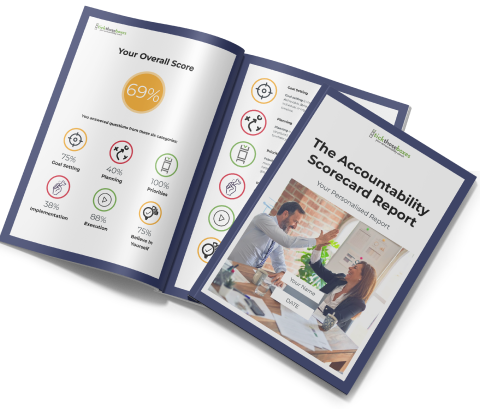Every business wants to grow, but growth comes with its own set of challenges. Despite the excitement of expanding into new markets or adding more staff, there are hidden risks. Without anticipating the unforeseen, even the most well-thought-out plan may face setbacks. That’s where risk management comes in. It allows you to move forward with more certainty and less guesswork.
Discover your Accountability Score and increase the probability of smashing your GOALS and Getting Sh!t Done!
By putting the right strategies in place, you can tackle problems before they take root. Knowing how to manage risks provides you with a strong foundation, whether you’re growing into new areas, introducing new products, or scaling your team. It helps protect what you’ve already built while giving your team the confidence to take the next step.
Understanding Risk Management For Business Expansion
Risk management is about spotting what could go wrong and figuring out how to deal with it early on. When a business expands, things naturally get more complex. Decisions affect more people, investments get larger, and one mistake can cost more. That’s why having a clear strategy to manage risk isn’t just helpful; it’s part of smart planning.
To understand why this matters, think of a construction company that decides to open a new office interstate. If they don’t assess workforce availability, local regulations, or supply chain issues in that region, their timeline and costs can spiral out of control. By identifying those risks upfront, they can better manage the transition and keep the expansion smooth.
Risk management gives you a map to steer through new territory. It helps you:
– Protect your cash flow and resources from unexpected costs
– Stay compliant with local rules and changing regulations
– Prepare for shifts in customer demand or market trends
– Safeguard your business reputation by avoiding missteps
– Give stakeholders confidence in your growth plans
The goal isn’t to eliminate risk completely. That’s not realistic. The aim is to know what’s likely to go wrong and have a plan in place. This gives your team the tools they need to handle problems confidently and keep moving forward, even when things don’t go as planned.
Identifying Potential Risks
Before you can manage risks, you need to know what they are. While business expansion presents new opportunities, it also exposes your company to both internal and external challenges.
Internal risks come from within your business, like overstretched finances or poor communication. When a business grows too quickly without enough cash reserves, it may struggle to cover payroll, stock, or unexpected expenses. If teams aren’t aligned or systems If you don’t scale properly, operations may come to a complete stop.
Here are a few internal risks to watch out for:
– Financial strain caused by new locations, staffing, or equipment
– Gaps in leadership or unclear roles during rapid scaling
– Overdependence on a single person or team for key decisions
– Software or systems that no longer handle the increased demand
External risks come from the environment in which your business operates. These can be harder to predict but still need attention. Competitors may adjust their strategies once they notice your growth. Rules might change in a new location, or the economy could suddenly shift. All these things make planning ahead even more important.
Some common external risks during expansion include:
– Market uncertainty and customer behaviour changes
– Delays in the supply chain or logistics due to increased demand
– Legal risks related to compliance in new regions
– Higher exposure to reputational damage if mistakes go public
By getting clear on these risks early, you’ll give your team a chance to respond before things snowball. It also helps you make smarter choices about where and how to grow.
Developing A Risk Management Plan
Once you’ve identified what could go wrong, the next step is building a plan to handle it. A robust risk management plan eliminates any uncertainty. It’s written down, easy to follow, and gets reviewed regularly.
Start with the basics:
1. List all the risks you’ve identified, both internal and external
2. Rank them by likelihood and impact, so you know what to focus on
3. Note what you’re already doing to address each one
4. Come up with action steps for risks that are still uncovered
5. Assign responsibility so it’s clear who needs to step in if needed
The clearer the plan, the easier it is for others to follow it when it matters. A business advisor can help you avoid blind spots during this step. Working with other businesses that have expanded provides them with valuable perspective, ensuring you don’t overlook anything crucial.
Putting this plan in place early allows you more time to make thoughtful decisions instead of reacting under pressure. It’s like carrying spare tyres and a toolbox before a long road trip. You hope you won’t need them, but you’re prepared if something doesn’t go as planned.
Implementing Risk Mitigation Strategies
Once the risk management plan is in place, the next step is putting actions into motion. Risk mitigation is about reducing the chance of issues happening and softening their impact if they do. It’s best approached as a continuous process instead of a one-time fix.
Here are practical ways to minimise risks during expansion:
– Spread investments across different markets or products
– Keep a steady cash buffer to manage unexpected costs
– Improve operational workflows before scaling
– Stay aware of compliance rules and local licensing
– Clarify who makes decisions when problems arise
Small improvements within operations matter too. For example, a design agency adding a second office location took time to prepare one of their senior project managers as a backup decision-maker. That way, if the director was unavailable, the business wouldn’t stall waiting on approvals. These kinds of steps often save time, money, and stress down the line.
Clear planning means quicker responses when problems arise. It also makes your team better prepared and more confident when facing the unknown.
Monitoring And Adapting Your Risk Management Plan
The most effective plans are living documents, not static ones left sitting in a drawer. As your business grows, conditions will shift. It’s important to track how well your plan is working and improve it over time.
Start with scheduled reviews. Set times throughout the year to verify your plan and update it. During each review, ask yourself:
– Have we faced any new risks that aren’t on the list?
– Did our actions make a difference when problems came up?
– Has the business changed in a way that creates new risk?
If anything shifts, like a new partnership, a move, or an added service, your plan should reflect that. Maintain open communication among team members to promptly identify potential risks. Encourage everyone to speak up, even for small issues. Often, those early signs help stop bigger trouble later.
Tools like traffic-light systems or simple scoring can help track progress. If a process once marked as high-risk now runs smoothly, it can be downgraded. If something starts to slip, you bump it back up and give it more attention.
The goal isn’t perfection. It’s about staying alert, adjusting as needed, and being able to act without delay.
Empowering Your Team For Risk Awareness
Good risk management isn’t something one person can own. It takes a team effort. When everyone is aware of the risks and ready to respond, you build a safer and more consistent business.
Clear communication makes a big difference. That means making sure your team:
– Knows their role when problems arise
– Feels confident speaking up about potential risks
– Gets involved in improving existing operations
– Understands risk management through regular training
Let team leaders help shape updates to the plan. They often know what’s working—and what’s not—before anyone else. Giving them a voice improves the plan and builds trust.
Make it simple for everyone to raise concerns. And when someone calls out a risk or solves a problem before it grows, they should recognise that effort. Rewarding proactive behaviour helps set the tone for a smarter, more alert team.
A strong leader sets the tempo. If management responds calmly to risk and leads by example, that steadiness filters through the entire business. Suddenly, problem-solving becomes part of daily work instead of a surprise reaction.
People usually notice issues early. They see bottlenecks, spot delays, and hear customer pain points. But without the right channels to share those insights, nothing changes. Establishing a culture where speaking up is normal can offer real protection.
Navigate Growth: Smart Business Risk Tactics
Expanding a business is a sign of momentum, but it’s not without hurdles. Risks can appear quickly or build up over time. By approaching growth with a sharp eye on risk, you give your business a better chance to thrive.
Identifying risks, planning ahead, and involving your team all help balance confidence with caution. A well-prepared business isn’t just reacting—it’s staying one step ahead. A steady, practical risk management strategy opens the door to growth that sticks around.
For steady, practical support as your business expands, partnering with a business advisor can help you handle challenges with confidence and clarity. At Tick Those Boxes, you’ll get the guidance you need to keep your growth plans on track—without losing sight of what matters most.


